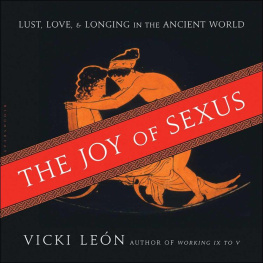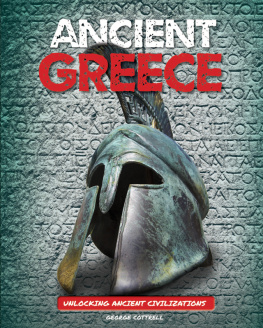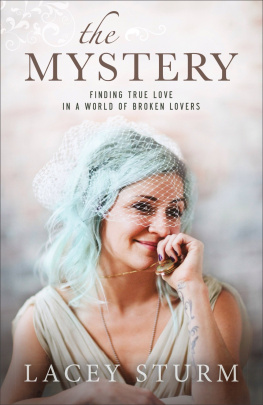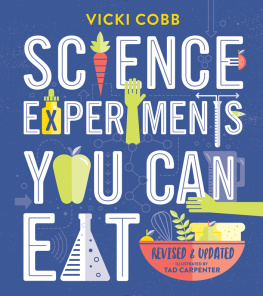
Contents
Section I
The Birds, the Bees, & the Body Parts
Section II
Sexual Pioneers Around the Mediterranean
Section III
Legendary Loves & Sometimes-Real Romances
Section IV
Love Hurts. But Changing Gender Really Smarts
Section V
Red-Letter Days & Red-Hot Nights
Section VI
Love Is a Many-Splendored Thing
Section VII
For the Love of ItPure Passions
Section VIII
Demon Lovers & Gods Dark & Light
Section IX
Love Dilemmas & Lust at the Crossroads
Youve read the clichs about platonic love, heard about Sappho and lesbian relationships, seen the Roman orgy movies. But what was sexuality really like in ancient times? Did the Greeks and Romans get married only to have procreative sex, or was erotic pleasure part of the bargain? What about romantic love, and who shared it? Did anyone call themselves transgendered? And what was the true status of gays?
Scientists, wildlife researchers, and religious leaders have declared for centuries that human homosexuality must be an aberration or a choice, because it does not occur in the natural world. Wrong. In our times, to the surprise and delight of many, biologists and researchers in the field have observed more than 450 different species engaging in same-gender mating activities, including bighorn sheep, albatrosses, beetles, bison, bonobos, ostriches, guppies, warthogs, flamingos, and various species of butterflies.

Orgies might look chaotic but an emcee directed activities. No last-minute walk-ins, either; members only.
Their hijinks have been noted in the New York Times and elsewhere, with piquant details such as these: A female koala might force another female against a tree and mount her releasing what one scientist described as exhalated belchlike sounds. And further: Male Amazon river dolphins have been known to penetrate each other in the blowhole.
With these discoveries, the whole paradigm of sexuality has changed. Instead of just the Darwinian imperative to pass on our genes, it appears that a certain saucy broad called Mother Nature might also just like to have fun. As yet, we dont know how these same-sex activities among creatures other than humans impact reproductive strategies. Who knowswe may find they create indirect ways of survival in a whole host of species, including our own.
Another factor besides evolution is in play here: biological exuberance. The jaw-dropping variety of animal and plant life covering this planet carries out its sexual mission in countless complex ways. None of it is aberrant. All of it demonstrates the lavish way in which life exhibits its rainbow of options.
As author Bruce Bagemihl argues in his book Biological Exuberance, given the apparent purposelessness of so much mating activity in the wild, scientists have had to rethink their basic models of what sex is all about. His take on it? Sex is lifes celebration of its own gaudy excess. Its an affirmation of lifes vitality and infinite possibilities; a worldview that is at once primordial and futuristic, in which gender is kaleidoscopic, sexualities are multiple, and the categories of male and female are fluid and transmutable.

Most centaurs were half-male, half-horse, but whos to say there werent mythical chick centaurs among them?
In countless ways, the ancient Greeks and Romans would agree with his theoryand confirm it. Although some were sophisticated thinkers, most were plainspoken, earthy folk. They treasured physicality. Knowing early death too well, they lived in the moment. They absorbed life through their pores.
Although Greek and Latin words and roots were used to create such terms as heterosexual, bisexual, homosexual, and lesbian, both cultures would have looked askance at these labels. To them, all manifestations of love and erotic behavior were somehow connected, all part of a whole. Men and women alike craved love but also feared its power; they called it the thunderbolt, that love-at-first-look feeling. To them, love could have claws. Passionfulfilled or unrequitedcould be as bitter as myrrh.
With trepidation, they entered the game with joy nonetheless. And they played it in a dizzying variety of waysfemale-to-female relationships, male-to-younger-male courtships, same-sex wedded couples, male-female marriages, short-term liaisons, dynastic incest, bonded military lovers, and still other combinations youll get to know in this book.
As in todays world, love took many forms, from maternal to altruistic, from hard-hearted to passionate. No one has a definitive answer as to why the Greeks and Romans of both genders handled their sexual urges and love imperatives in the complex way they did, but several aspects of those cultures offer provocative clues.

As the Greeks knew, Cupids arrows stung, often randomly scoring a bulls-eye.
First of all, neither the Greeks nor the Romans thought about sinfulness and guilt in the Judeo-Christian sense. The idea of mankinds fall from grace never occurred to them. Even women, despite having to endure a lifetime of domineering males, would laugh incredulously at the thought of sex being a sin. Adultery could be a crime, as could rape, but for reasons other than sinfulness. A tangle of laws eventually would seeknot always successfullyto control some sexual behaviors and criminalize others.
In their polytheistic societies that we call pagan, there were no churches or congregations as we know them, no priests to lecture or act as middlemen to a deity. They believed in a celestial place, jam-packed with gods and goddesses who were divine yet flawed. In them, Greeks and Romans saw themselves, at once perfect and imperfect. Some of their supreme beings were lifelong virgins: Artemis, Athena, and Vesta. Other deities were sex addicts, troublemakers who rarely paid a penalty for their misbehavior. Sex, love, jealousy, and revenge were integral parts of the gods lives, and thus it seemed right that human lives should echo them.
As John Clarke, author of Looking at Lovemaking: Constructions of Sexuality in Rome Art, says: The Romans are not at all like us in their sexuality Here was a world before Christianity, before the Puritan ethic, before the association of shame and guilt with sexual acts. And it is a world that had many more voices than the ones we hear in the ancient texts that have survived.

Shes awfully short, but I could still get aroused.
Both Greeks and Romans felt the urgent need to have more than one deity on the job to handle the myriad aspects of love and sexual activity. Not only that, but both cultures freely borrowed deities from one another or created parallel ones: the Greek Aphrodite and Eros paralleled the Roman Venus and Cupid, for instance. Since marriage therapists, daytime television, chat rooms, and self-help books were not yet on tap, the love deities eventually amassed an entourage of minor gods devoted to different aspects of passion, from seduction to unrequited love. The same applied to deities of sexuality, fertility, marriage, and childbirth. They were equally important in the everyday lives of long-ago people, who routinely sought their advice and asked them to intercede in their personal lives.
Next page











